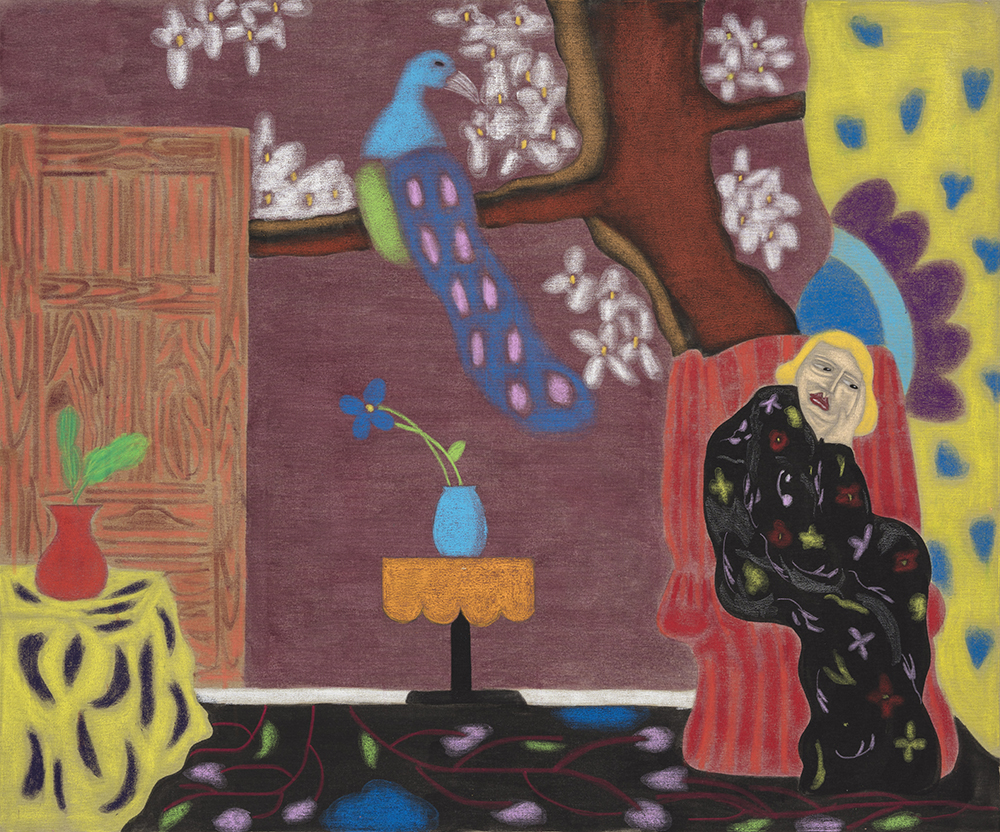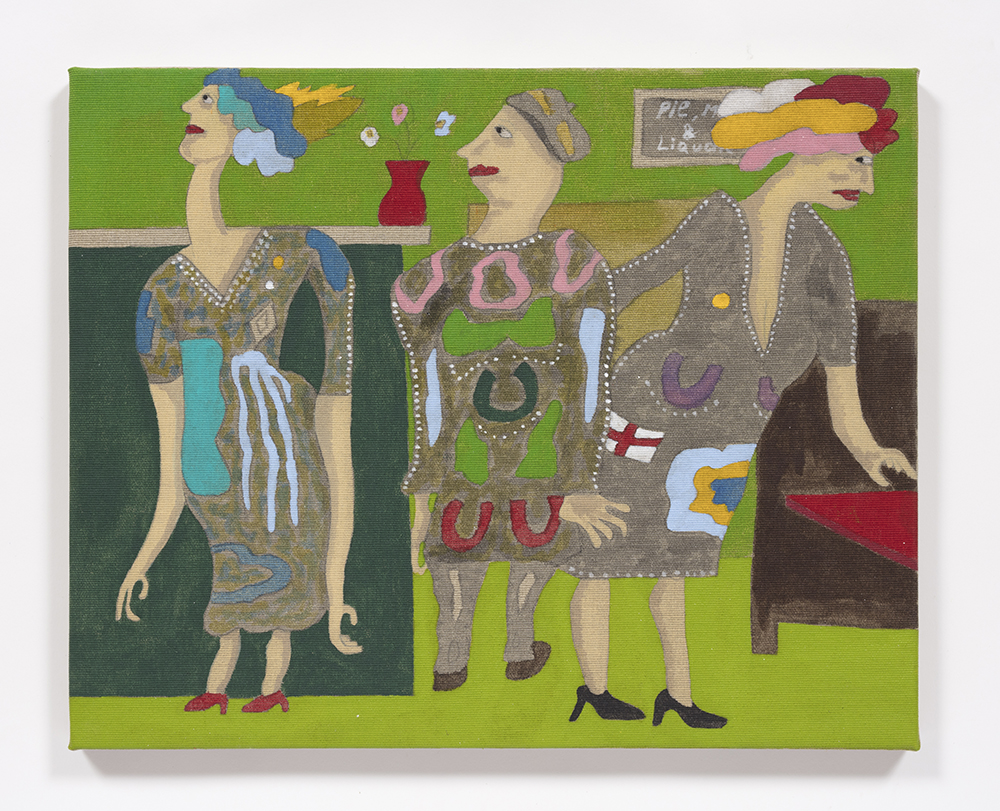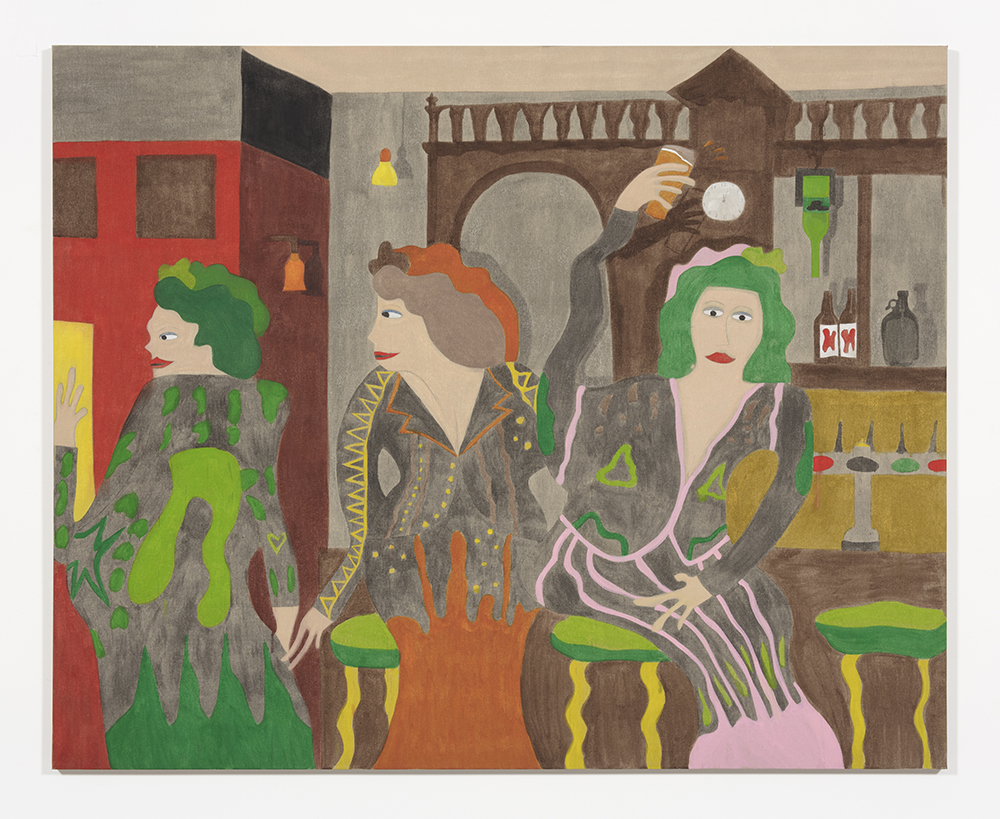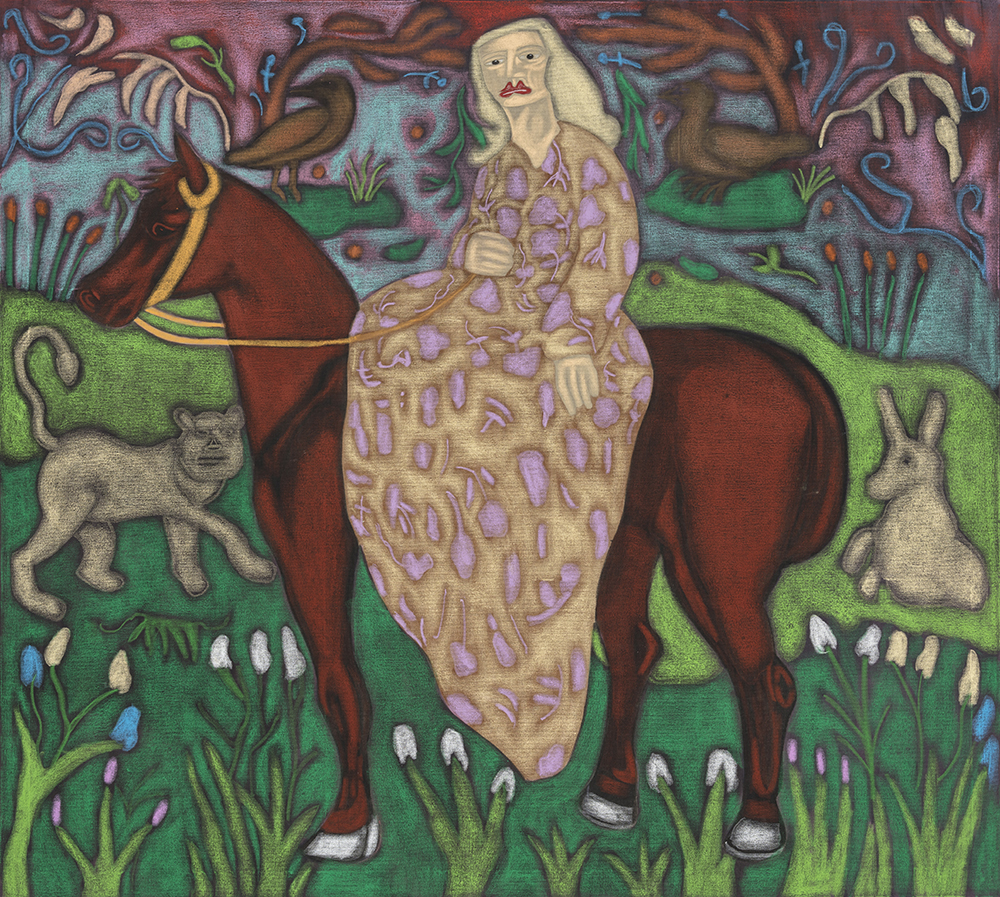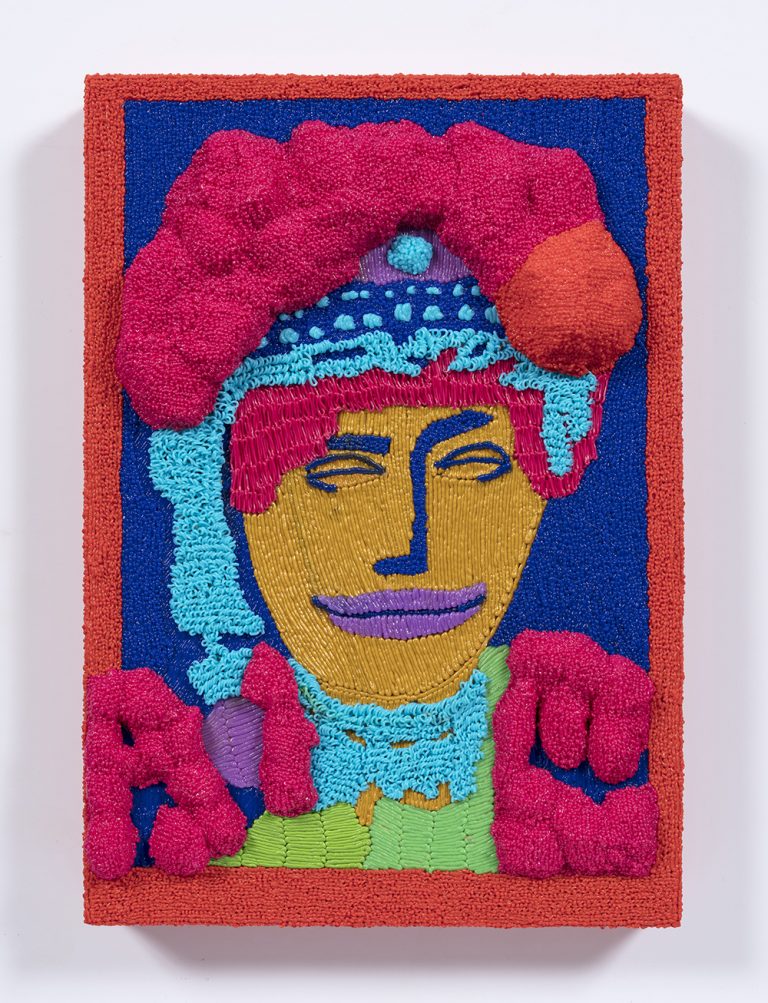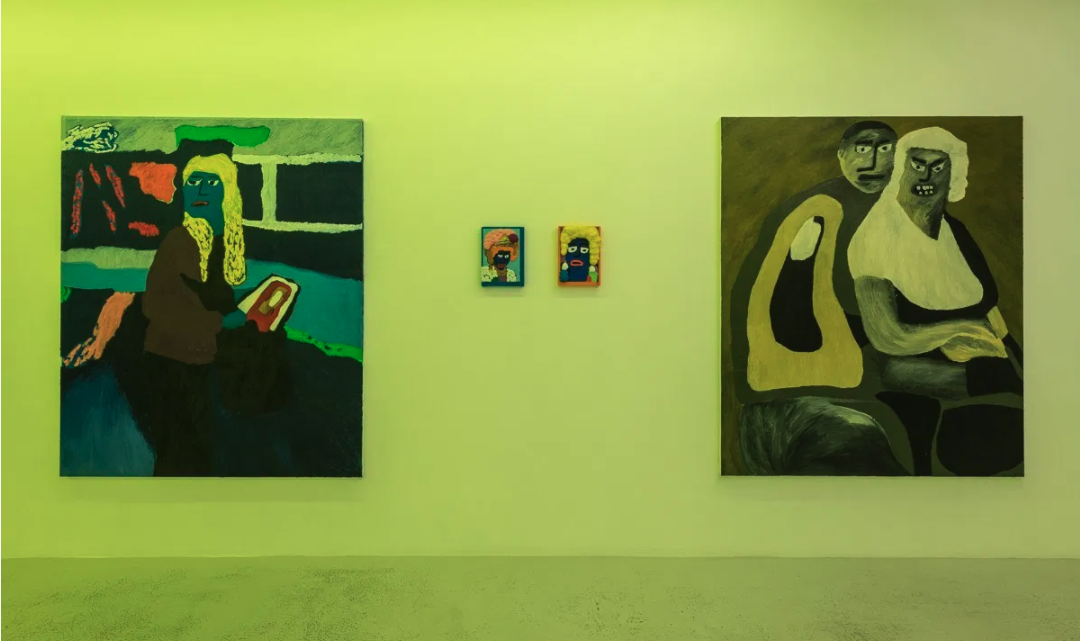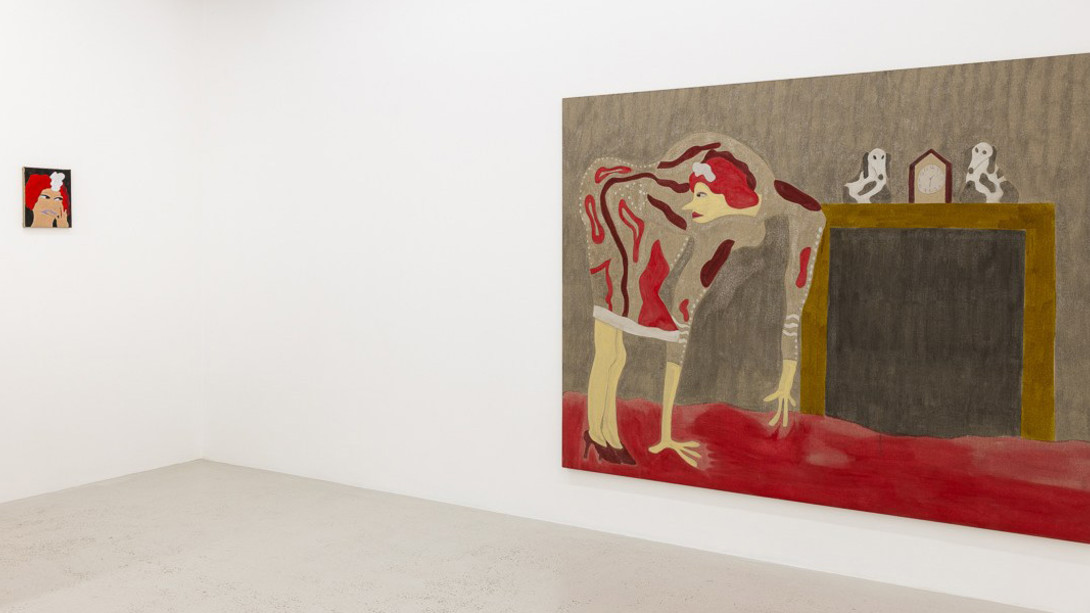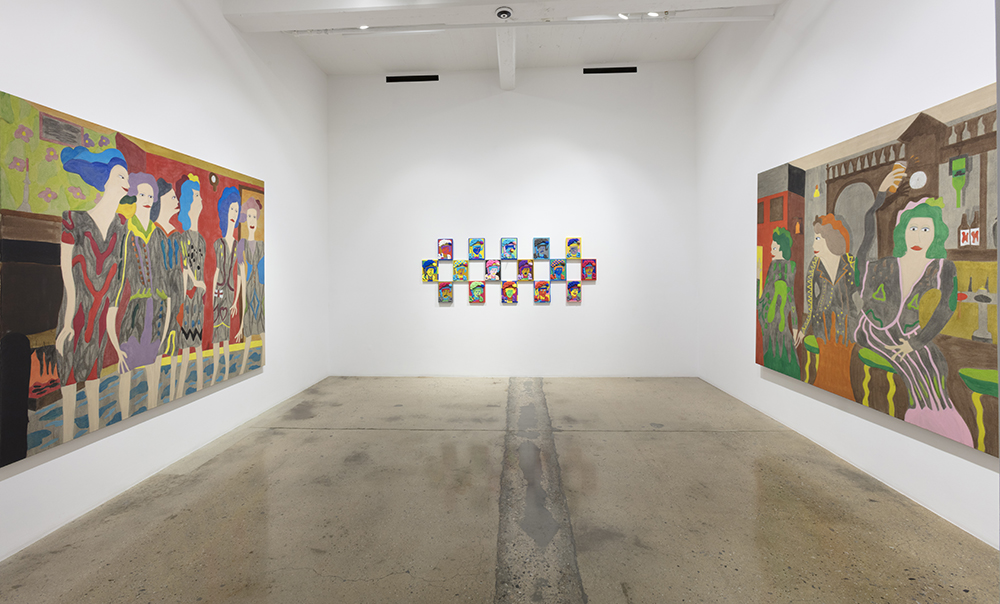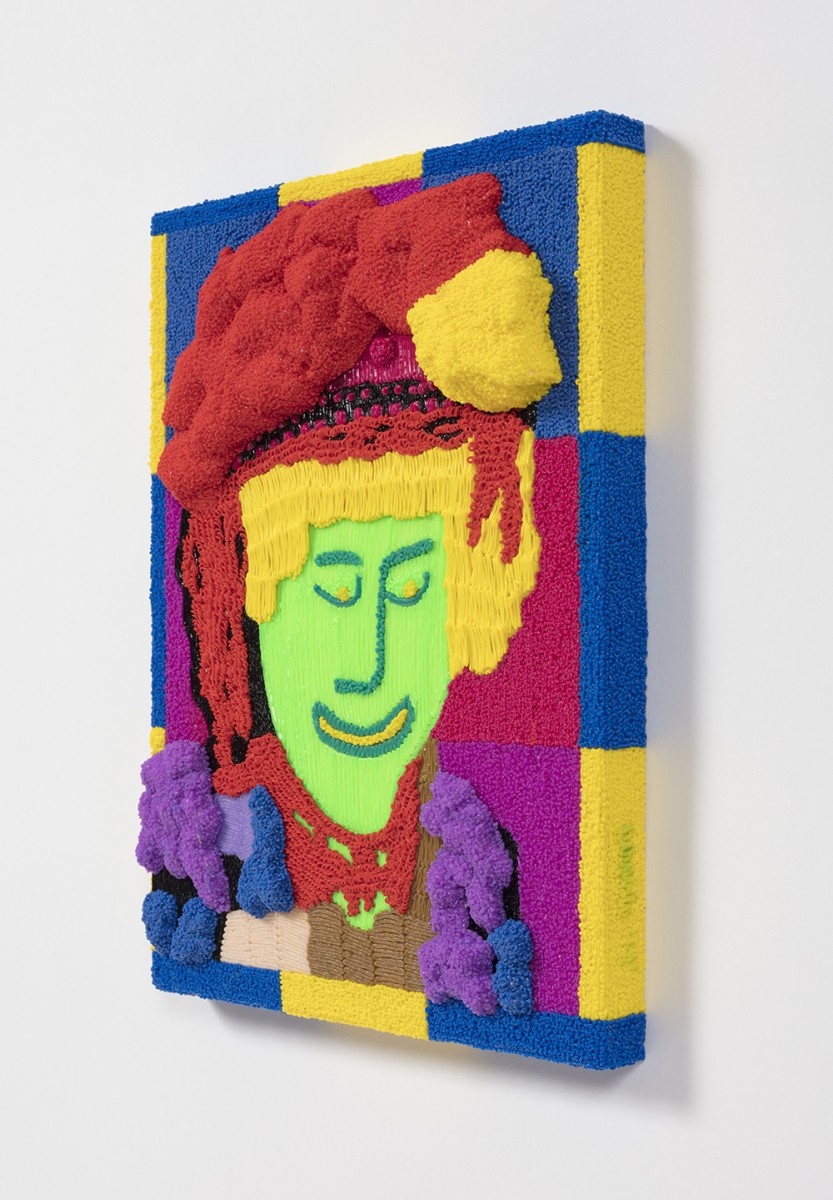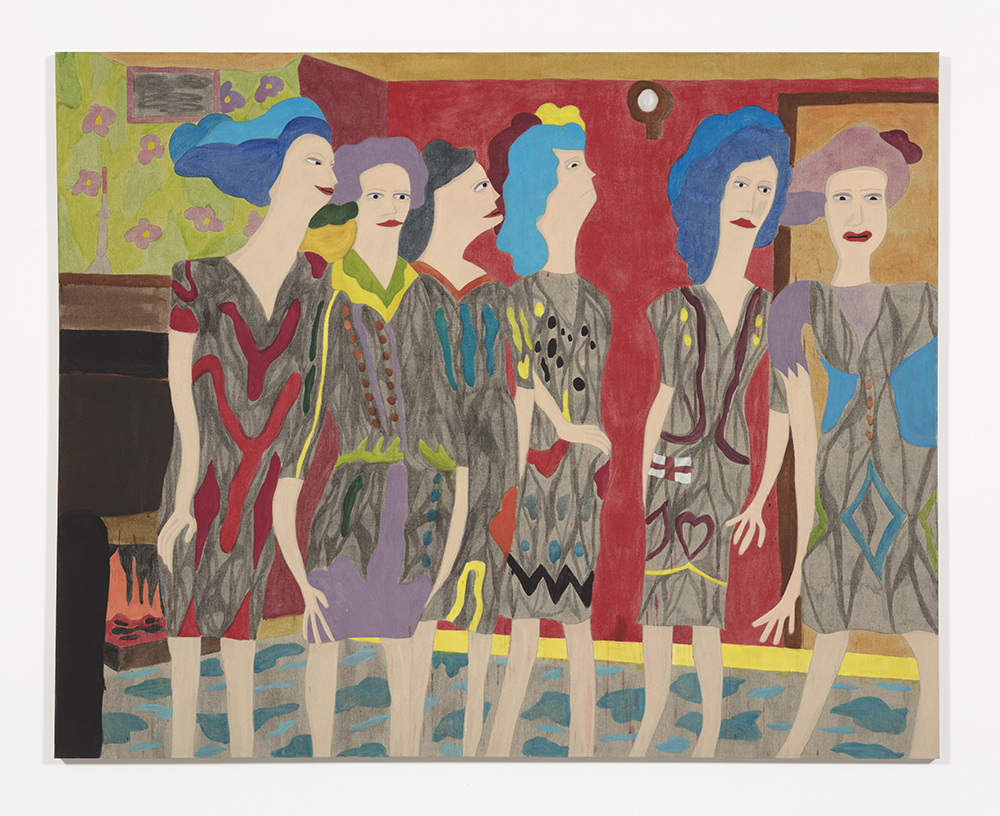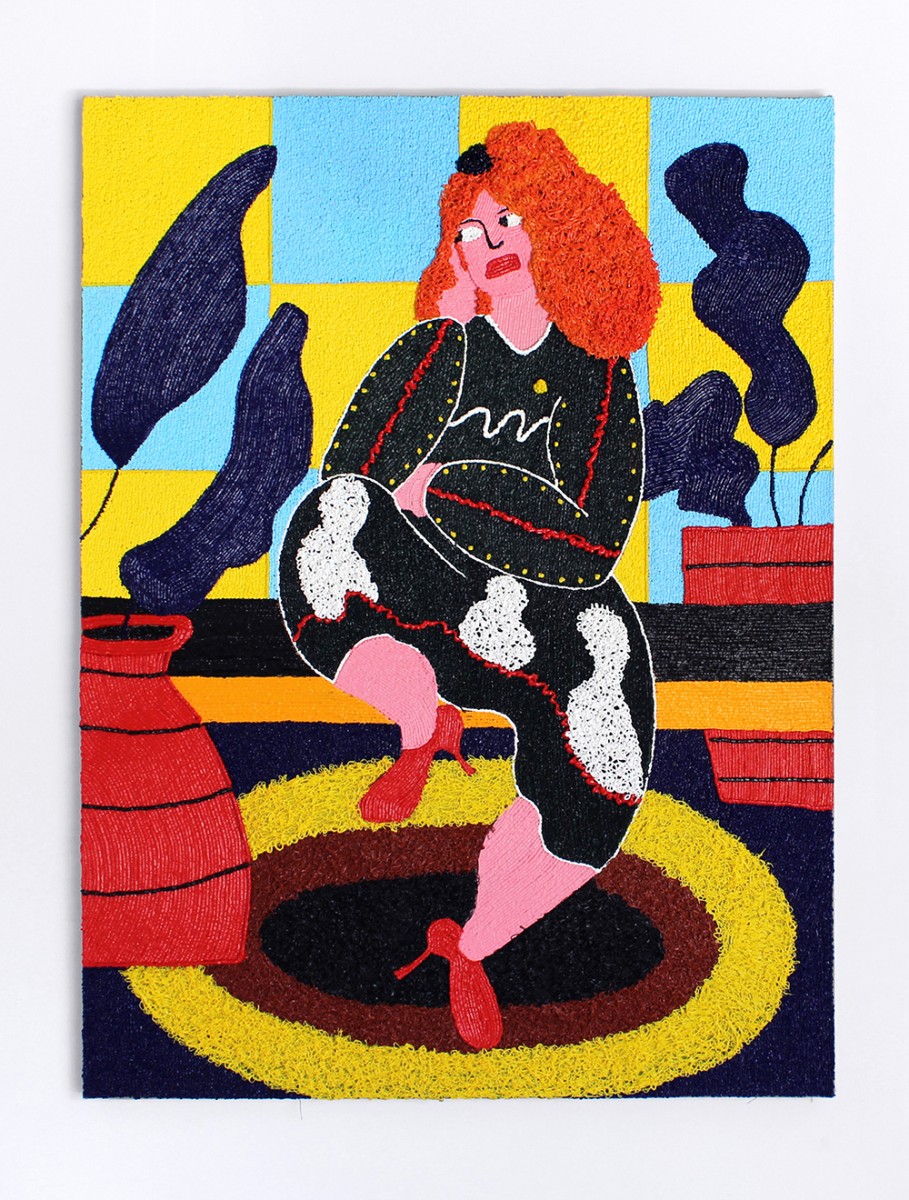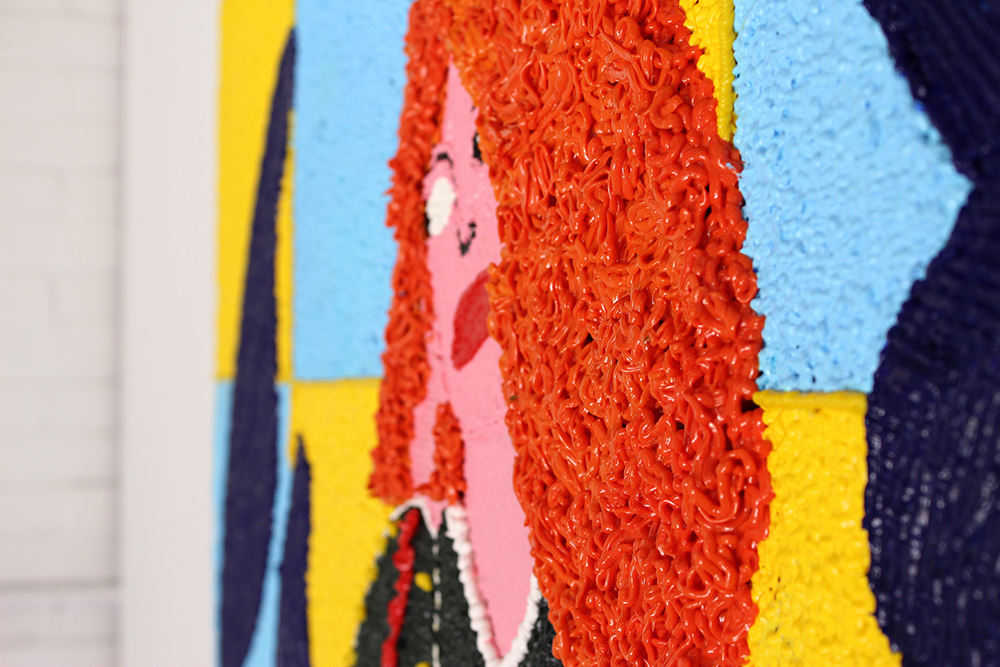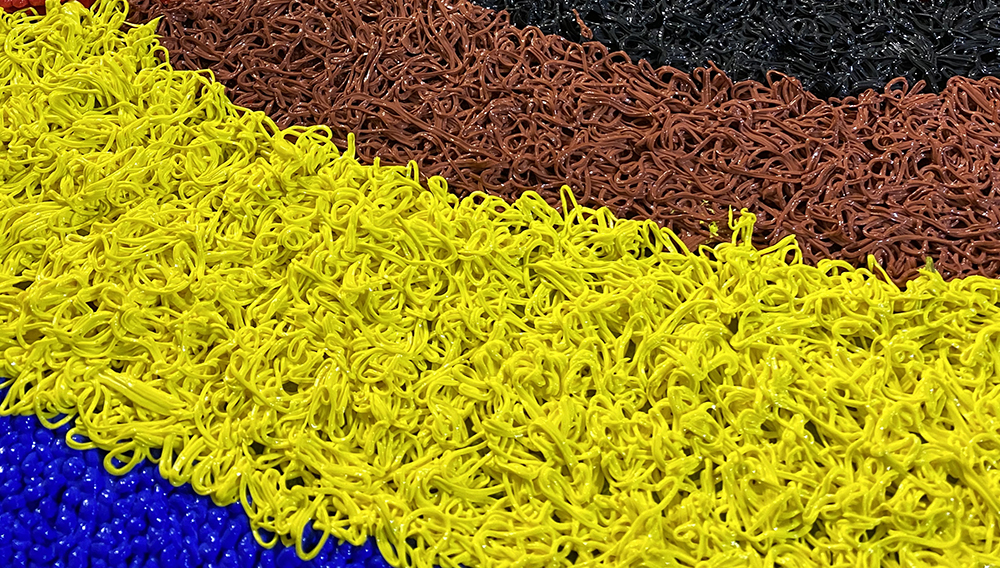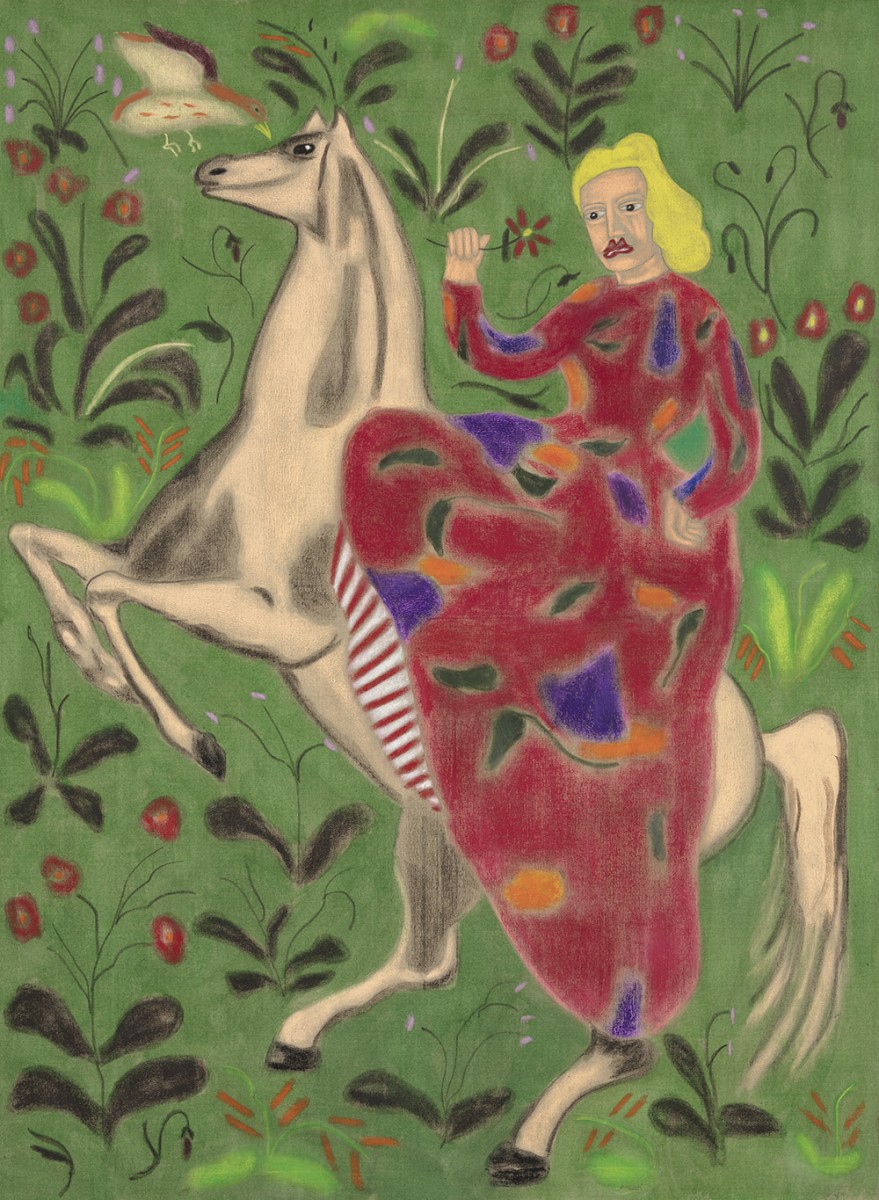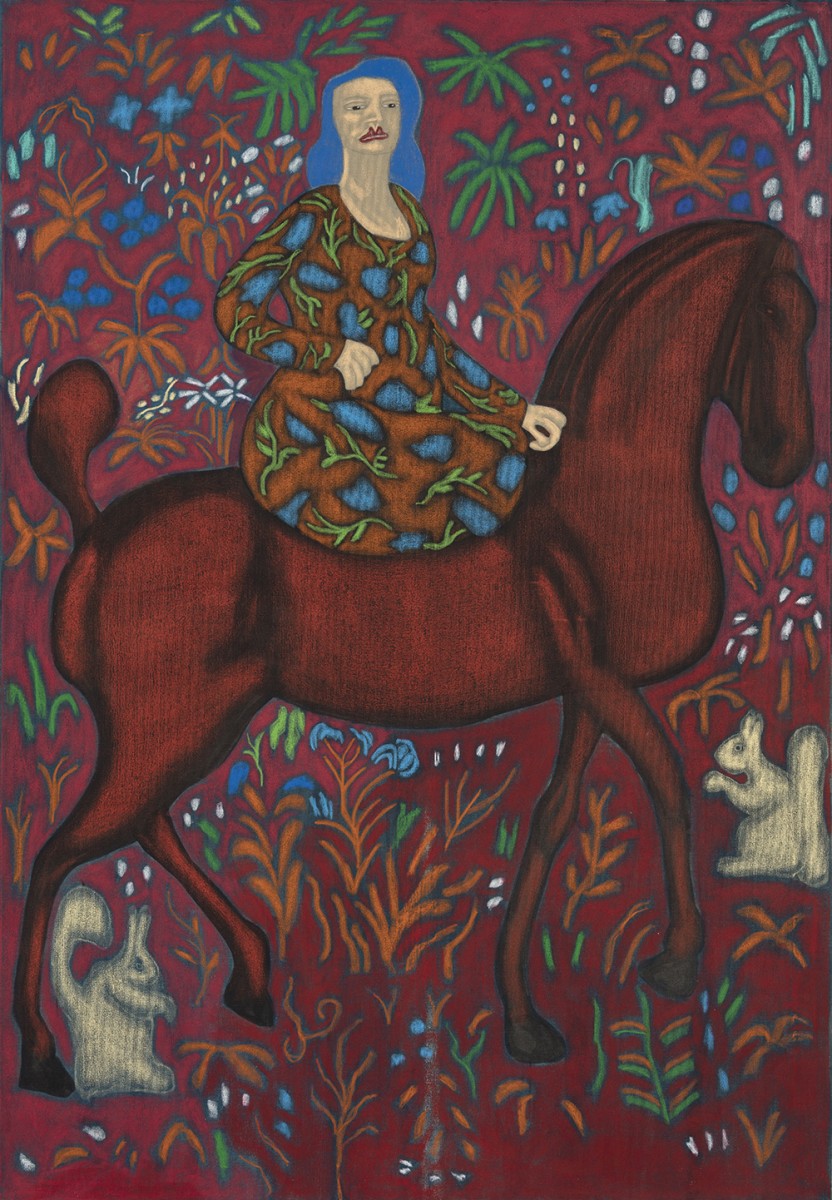
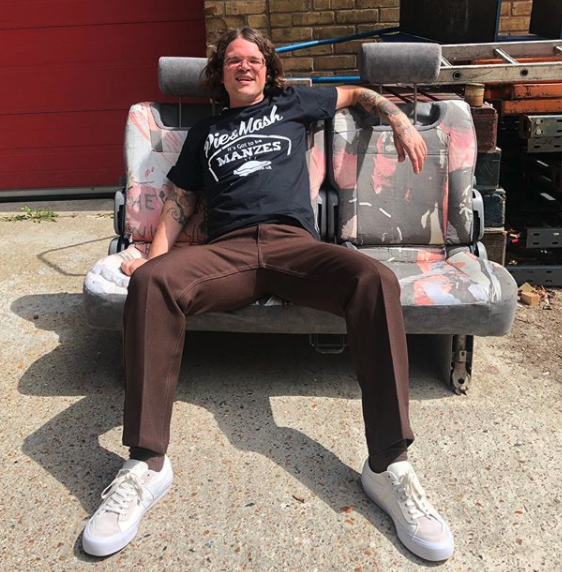
Dominic Dispirito (b. 1982, London) earned a BFA from Middlesex University, London (2013) and an MFA from the Slade School of Fine Art, London (2017). Dispirito has had solo exhibitions at Steve Turner, Los Angeles (2019) and Anna Kultys Gallery, London (2018 & 2019). He has also had work in group exhibitions at Steve Turner (2019) and The Dot Project, London (2017). Dispirito lives and works in London.
Dominic's paintings celebrate the British working class and his upbringing in the heart of Cockney London. Among them are those that depict “Pearly Queens,” Cockney characters who originated in Victorian London and evolved from the Coster Kings and Queens, the elected leaders of London’s street hawkers. Other works depict a single figure that represents the artist’s mother, a frequent subject in his works, and someone who in turn is meant to represent working class London in a time of transcendent crisis. Dispirito’s latest works were made by piping brightly colored acrylic paint through icing bags.
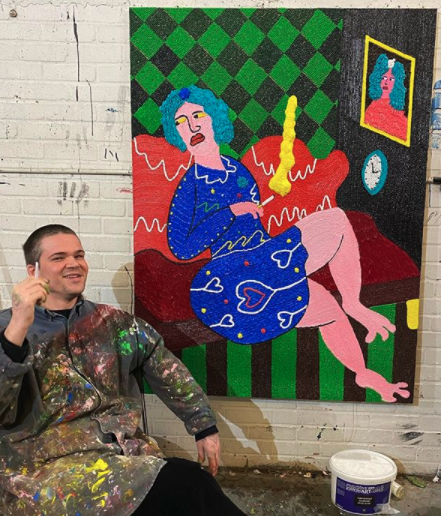
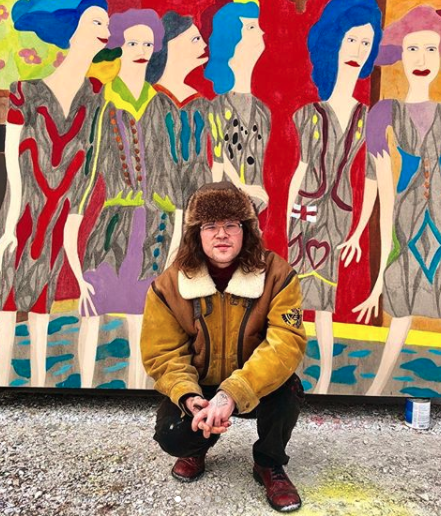
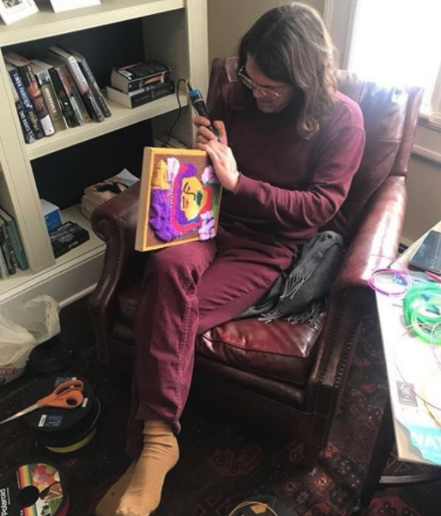
Steve Turner:
Let’s start with some background information. Can you describe your youth, where you grew up, the dynamics within your family and any strong early influences.
Dominic Dispirito:
I grew up in an area called Holborn, which is in central London, in the borough of Camden. I come from working class people of a Cockney background. Contrary to popular belief, you do not have to be from the East End to be a Cockney. Historically, to be Cockney, you had to be born within the sound of the “Bow Bells” of St Mary-Le-Bow Church which is in Cheapside in the city of London. Holborn is mostly affluent, but like all areas of London, the rich are right next to the poor. Most people are not aware that Holborn also has a lot of poverty and crime. I come from a loving but dysfunctional family. My parents really tried their best with the tools they were given. My dad always made sure that we had what we needed and more. He would take me to football games to watch Arsenal play. He made sure I had money to go to the cinema with my friends. He made sure we had enough clothes and he put dinner on the table. But my parents also had their own demons. There was a lot of domestic violence in my household fuelled by alcoholism and drug abuse all of which definitely had an impact on me. I later became an alcoholic and was addicted to drugs. This was no fault of my parents. From what I know they were also brought up with a certain level of dysfunction. We are all products of our upbringing and the society in which we live. In regards to an early influence on my art career, it’s really difficult for me to pinpoint where this came from as my parents aren’t interested in the arts whatsoever. We never visited galleries and being an artist isn’t seen as a real job among working class people. On the other hand, not having had a strong artistic influence in my childhood gives me a nice satisfaction now. It makes me know that I am really doing what I was born to do. Curiously, my brother also is an artist–he is an actor, screenwriter and director.
ST:
Tell me more about being Cockney. Are you saying that even though you did not live close enough to hear the bells that you are still Cockney? And what does it mean to be Cockney?
DD:
Yes, that is what I’m saying. To be born within the sound of the bow bells is the traditional definition of a Cockney. These days anyone with a working class London accent is likely to be called Cockney. If I was born in 1900 I would have been able to hear the bells from where I grew up, whereas today it can only be heard within the boundaries of the City of London. This is because London has become more built up and more populated and the sound of the bells has been drowned out by the noise of the city. But really, being a Cockney means so much more than whether you can hear some old church bells ringing, it’s more like an attitude, a way of life.
ST:
And since your work is very much about being Cockney, let’s pursue this a bit more. What is a Cockney attitude? What is the way of life?
DD:
I can only speak from my own experience though I’m sure my family and friends would agree with me. It is about being a family, about going to watch football together, about going down the pie and mash on the weekend, about going down the pub to have a couple of drinks, about having a laugh, about sometimes being a little bit naughty and either winding someone up or causing some sort of trouble, about standing up for yourself and looking after one another, sticking together through the good times and the bad. But it was also very much an us against them attitude, if you were different we didn’t like you, you weren’t “one of our own”. With hindsight I now know that being pissed off at anyone who is different is a problem within our society, I have been lucky enough to become more educated on these matters, throughout the years my perspective has changed and I no longer think in this toxic way. But as I mentioned earlier, working class people are in no way to blame for this thinking, they are an oppressed people and they are angry and they feel like they need to point the finger somewhere, really we are all just products of the society in which we live.
ST:
And I assume being Cockney is not about having a long line in England. I am guessing from your Italian last name that your family has not been in England for many generations. Am I right?
DD:
Yes, that’s correct. I’m the third generation born in England. My great grandad on my father’s side moved to Clerkenwell (London’s Little Italy) from Rome just over one hundred years ago. Every descendant has had a Cockney accent. My mum is from up north, a small town called Ferry Hill near Newcastle. She moved to London when she was nineteen years old and has since lost her northern (Geordie) accent so she too is a little bit Cockney now.
ST:
Now that I better understand your Cockney roots, tell me something about your education. I know you had formal art studies in London, your MFA at Slade and your BFA at Middlesex. It seems you were something of a late bloomer, finishing these programs when you were thirty-one and thirty-five years old. What did you do before you got serious about being an artist?
DD:
Yes that’s correct if we are talking only about formal art education, although I have had the talent and inclination to be an artist since I was very young . When I started on my BA, I was twenty-six compared to the typical student who was twenty. When I was eighteen years old I worked as a shoe repairer for two years because I was encouraged by my dad to get a trade. This is typical if you are from a working class background. I was not encouraged to go to university, especially not to study art. I was never happy with this job because all I really wanted to do was make art. Unfortunately, I had a much more serious problem that had consumed my life. By the time I was twenty-one, I had developed a serious addiction to drugs and alcohol and was admitted to rehab. For the next six years, I was in a bad cycle of drinking and taking drugs followed by attempts to get sober. I was admitted into rehab twice more, I lived in numerous half-way houses and supported accommodation. I spent time being homeless. I had lots of counselling and therapy and came very close to spending time in prison. I spent three years on probation and was very lucky that I wasn’t admitted into a psychiatric ward. Eventually I hit rock bottom and thank God something clicked inside me. I got sober and I got my life back. I know I am lucky to be alive. In my first few years of sobriety I felt tremendous regret for the years I lost, but I now realize that I didn’t really lose anything. The experience I had with alcoholism and drug addiction made me the person I am today and it’s possible that I might not have pursued an art career if I didn’t have those problems. By the time I started my MA at the Slade I no longer felt behind as most of the students were of similar age.
ST:
I know the work you have been making over the last couple of years, paintings of Pearly Queens, fanciful images of your mom on horseback and Cockney folk in interior scenes. Were these subjects part of your focus when you began your studies or did you develop new interests, styles and techniques over time.
DD:
I developed these themes after I graduated from Slade. When there I followed the pedagogic system they have in place which is to experiment as much as possible. I went through the whole of art history in two years. My tutor (Gary Woodley) said that in the twenty that he’s been working there he’s never seen a student experiment as much as I did. All of my previous work has led me to where I am today. It’s always been a process of finding out what works and what doesn’t. I believe that everything gets better with time and that no experiment is a waste.
ST:
Let me get this right. When you were in school, you did not make work that relates to your Cockney identity?
DD:
I did not. I was too insecure to let people know about me whilst I was studying. I didn’t see anybody there that came from the same background as me and I feared being judged. Once I was out of school, I felt more free, and since I have had some good reactions, I now feel totally free.
ST:
Since graduating from Slade you have had three solo exhibitions, two in London at Annka Kultys and one with us in Los Angeles. What was the premise of Council Housed and Violent, your 2018 solo show in London?
DD:
It had a strong political focus. The title of the exhibition is the long version of CHAV, a term that the British press has been using since the 1990’s to attack and undermine the working class. I created an immersive installation that included paintings, sculpture, a sound piece and neon lighting. There was less focus on individual works and more on the overall installation. I covered the lights in a disorientating yellow gel. The sound piece was based on one of many experiences of police harassment and bullying that I had encountered as a teenager. Looking back on this show, I see that it fulfilled a need I had to shed light on certain themes. However, I later realized that I want each individual painting to function on its own without reliance on its connection to other works.
ST:
What about the second show in London?
DD:
I was a lot happier with the paintings for my second solo show, I had one year between shows and I worked very hard to develop the paintings in this time. I put in a lot of hours each week in my studio focusing on developing interesting compositions with the right colours. I also had plenty of time to analyse the works after they were finished. Some got thrown out and others got necessary improvements.
The show was titled Pie and Mash in honor of a traditional Cockney dish that has been around since the 19th century. There are still a few pie and mash restaurants scattered throughout London and I have fond memories of meeting friends to have lunch in our local shop. Unfortunately a lot of these shops are closing down due to gentrification and I wanted to keep this Cockney tradition alive in my paintings.
ST:
And what about your 2019 show with me in Los Angeles?
DD:
Pearly Party also celebrated my Cockney background, it was about friendship, community spirit and love. The title refers to Pearly Queens, Cockney characters who originated in Victorian London, who evolved from the Coster Kings and Queens, the elected leaders of London’s street hawkers. Benevolent societies developed to aid the less fortunate, and parades were staged in which the “Pearlies” dressed in elaborate clothing that they adorned with rows and rows of mother-of-pearl buttons. I meant for them to represent the group of friends I had growing up, as if we were “the last of the pearly kings and queens”. In the last few years I have felt that the sense of community that I experienced is disappearing. With more gentrification, the Cockney identity as I see it is almost an endangered group. With that in mind, I want to make it more visible, at least in my art. With this show, I continued to focus on making the paintings strong as individual works and I took the opportunity to present works made with different techniques.
ST:
Please elaborate on the mix of painting techniques you employ and your choice of materials. I am curious to know more about your use of the 3D printing pen. How did you arrive at this technique, how does it work and what does it symbolize to you?
DD:
When I discovered the 3D pen I had a strong interest in new technologies and their influence on art making. I enjoy finding unconventional ways to paint. The 3D pen allows me to draw, paint and sculpt, all at once and I quite like that.
ST:
What about the two large paintings in Pearly Party? They were more conventionally painted on a fabric that you call “Jekyll linen.” What is that?
DD:
The material I use for these paintings isn’t actually linen. it’s a cheap version I buy at the Goldhawk Road Market in West London. For this reason I coined the term of “Jekyll linen”, “Jekyll and Hyde” is Cockney rhyming slang used to describe something which is fake. Jekyll and Hyde = Snide (which means fake). This fabric has properties that are essential for my technique. It allows the diluted acrylic paint to sit perfectly on the surface without becoming too absorbed into the fabric. I tried painting with diluted acrylic on various other materials and it didn’t work. I then started to paint on the back of old works because I had run out of money and in so doing made a great discovery. I learned that I could achieve the degree of translucency that I desired when the backside of a painting had already been primed but the front not. I love that this cheap “Jekyll linen” also works best. I later found out that Francis Bacon discovered his painting technique exactly the same way.
ST:
After not using the 3D pen for over a year, I note that all the works in your upcoming exhibition are made with this technique. What made you want to return to it now?
DD:
I am not actually using the 3D pen. I came up with something new. I had always wanted to make large works with the 3D pens, however because of the way they work, it was not practical. For the new larger paintings I used an acrylic paint mixed with an impasto medium that I piped through icing bags. I love the way it works and I love the resulting glossy finish. I use around five gallons of medium on each painting but it’s totally worth the expense because I love the paintings.
ST:
You clearly have a tremendous energy to create. It seems as though you sometimes work on multiple series at the same time, or that you might start one series only to put it aside when something else comes to mind. I am thinking of the paintings you made in the second half of 2019 that depicted a woman on horseback in an idyllic setting. What was behind that series and do you intend to continue dividing your output between works that are more thinly painted on linen and those that rely on the 3D printing tool.?
DD:
It is true. I love to work on different series and I love using different techniques. I like for some paintings to be thickly painted and I want others to have a more watery feel. The figure of a woman on horseback is actually my mother, I’ve seen my mum struggle in various ways in her life and the paintings are about wanting to give her a better life. Ultimately they are about the love I have for my mum. Their compositions were inspired by medieval tapestries, the kind you would see in a palace. It’s almost as if I am playing Robin Hood in that I am taking from the rich and giving to the poor.
ST:
With your second solo show with us now up, how do you feel about your progress of the last few years? Are you happy with the way your works have developed? Are you happy with the way your career has developed? I know that it is very expensive to live in London and that it must get tiresome to struggle financially. Do you think your desire to succeed is strong enough to sustain you?
DD:
I accept that everything that is worthwhile takes time, I can definitely see the development of my work over the last few years and I am very conscious of the need to work hard for that. The reaction of the viewer and the market is outside my control, but I feel confident that my work will gain more audience as time goes on. The financial struggle can be difficult at times, but I’ve made a decision to keep going no matter what. Where there’s a will there's a way and I will always have everything I need and more.
Please direct inquires to
steve@steveturner.la
jonathan@steveturner.la
